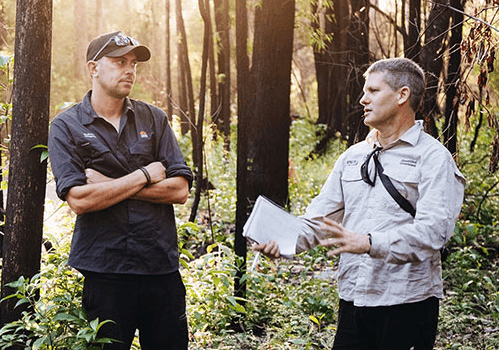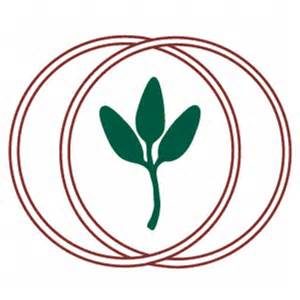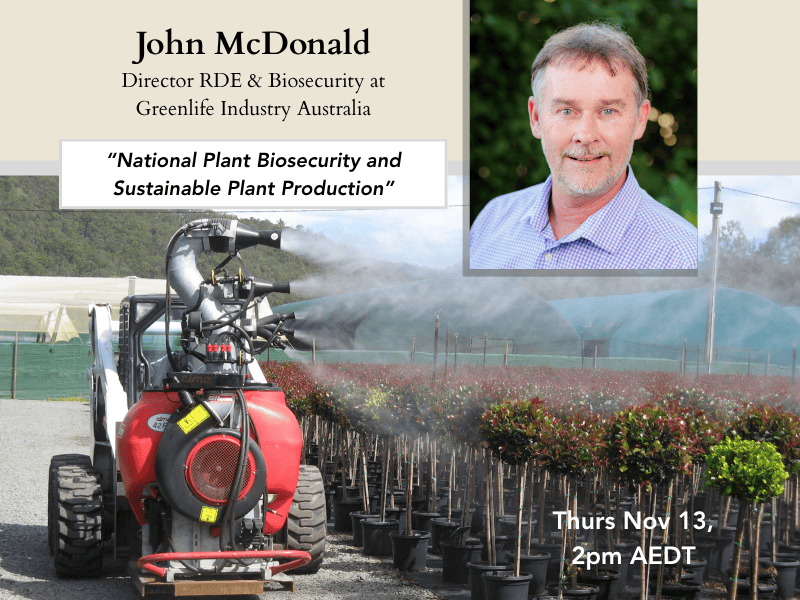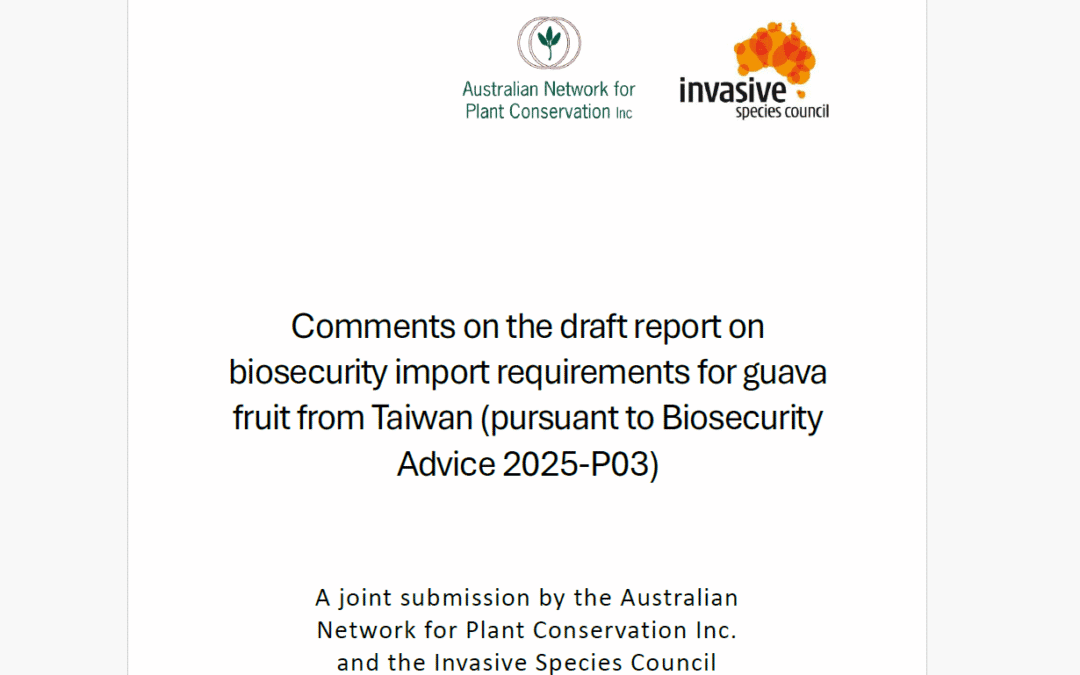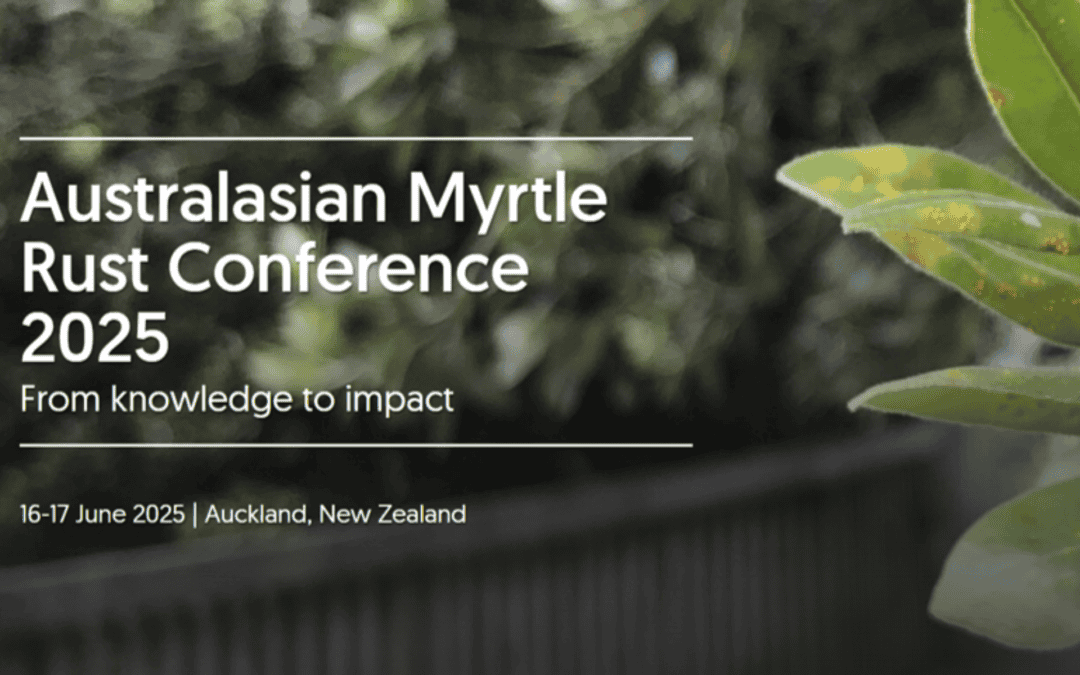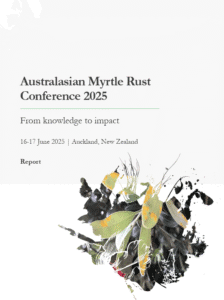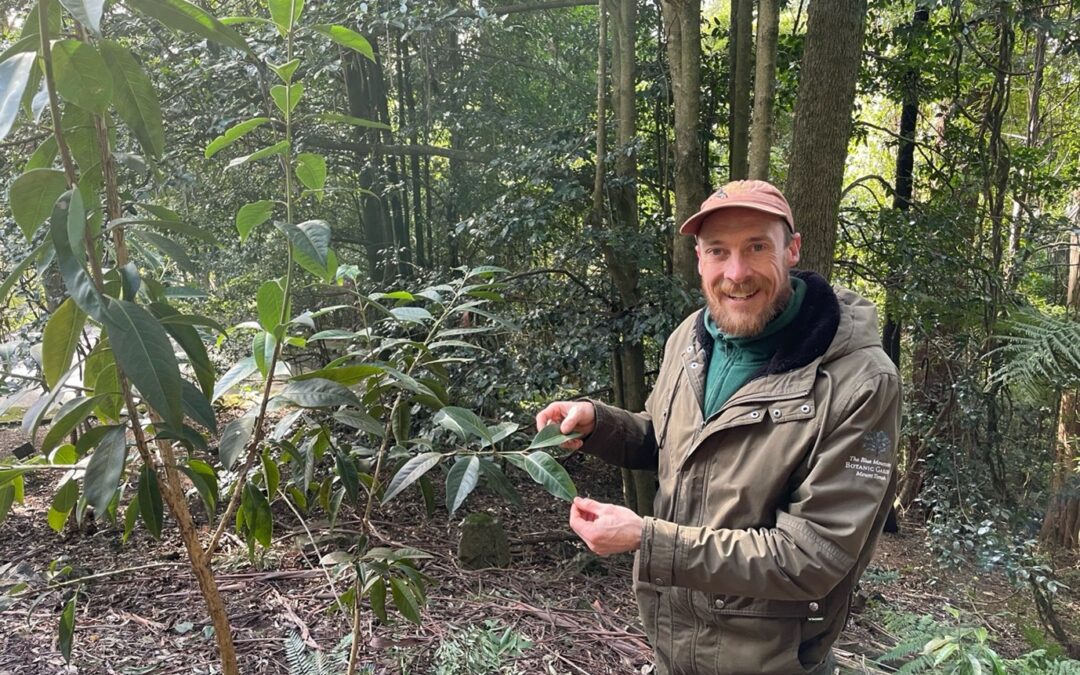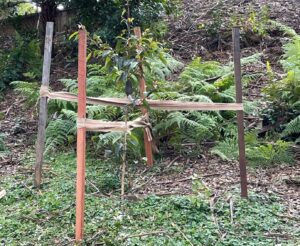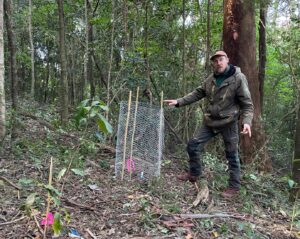
Jan 7, 2026 | News
The Department of Agriculture, Fisheries and Forestry (DAFF) have awarded their 2025 Australian Biosecurity Awards – Environmental Biosecurity to Dr Geoff Pegg and Aj Perkins. Geoff is Senior Principal Forest Pathologist Queensland Department of Primary Industries, and Aj is Senior Project Officer, Department of Climate Change, Energy, Environment and Water (NSW). Together they have collaborated and partnered with a wide variety of stakeholders on an innovative 2-year program which builds capacity to protect culturally significant species from the threat from introduced pests and diseases, including Myrtle Rust. The program included developing and delivering training modules for Indigenous Rangers and land managers to improve their ability to spot and report biosecurity threats. They also built a groundbreaking trans-Tasman partnership in Indigenous forest health and environmental biosecurity with Māori custodians and scientists from New Zealand (Aotearoa).
The success of the program has meant that it has been extended through to 2029.
The program also produced the fantastic Roots for Resilience video which tells the story of the importance of environmental biosecurity for culture, and highlights the need for collective action. It can be found here: https://youtu.be/d2M18ApA-uA?si=sMme1yzTERJrfXrG
Read the DAFF article about the award and Geoff and Aj’s work here: https://www.agriculture.gov.au/about/news/aba-geoff-pegg-aj-perkins

Oct 17, 2025 | Events Category
Session 6 of the Myrtle Rust management for practitioners – open series will be on:
“National Plant Biosecurity and Sustainable Plant Production”
The presenter will be John McDonald, who is the Director of RDE & Biosecurity at Greenlife Industry Australia. He will present on the national plant biosecurity system and response management, including:
Responding to an emergency plant pest incursion
Pesticide Minor Use Permits (MUPs)
– What are MUPs
– How to apply for a MUP
Nursery Production Sustainability
– Best Management Practice
– Environmental & Natural Resource Management
– Plant Protection and Biosecurity
Date
Thursday 13 November 2025 2:00 PM – 3:00 PM (AEDT)
Location
Online event access details will be provided by the event organiser
Register here (via Trybooking)

Oct 10, 2025 | News
Last month the ANPC and the Invasive Species Council filed a joint submission in response to the Biosecurity Import Requirements Draft Report issued with Biosecurity Advice 2025-P03, which recommends the allowing of importation of fresh guava fruit (Psidium guajava) from Taiwan. The Draft Report excludes Myrtle Rust (Austropuccinia psidii) from risk assessment on the grounds that it is not present in Taiwan.
We argue that this finding was not well justified – a concern validated by the confirmed occurrence of Myrtle Rust in Taiwan, reported after the Draft Report’s publication. Although DAFF now proposes to
conduct a risk assessment of Myrtle Rust, in the submission we provide a critique of the original decision to exclude Myrtle Rust from assessment, as well as recommendations for revision and to seek advice from experts in the National Myrtle Rust Working Group prior to publishing.
To read the full submission, click here.


Aug 15, 2025 | Events Category
The conference program including speaker abstracts is available here.
The Australian Government commissioned a report summarising the Australasian Myrtle Rust Conference 2025 proceedings to provide an overview of the current state of Myrtle Rust for the Australasian region as discussed during the conference.
Download the Conference Report here.

Conference presentation recordings are now available on the ANPC Youtube channel:
Many of Australasia’s best-known and most highly valued native trees – from Australia’s eucalypts to Aotearoa New Zealand’s pōhutukawa – are in the family Myrtaceae. Many species in this family urgently need protection from Myrtle Rust, a disease caused by the globally dispersed pathogen Austropuccinia psidii.
Collaborative research efforts have improved our understanding of our myrtles, the pathogen, and plant/pathogen interactions. Management tools have been developed and deployed, and communities are rapidly mobilising to protect and conserve native plants.
Researchers and community members from across Australia and Aotearoa New Zealand came together with an exciting line-up of talks on 16 and 17 June 2025, to share knowledge and celebrate our mighty myrtles and the progress made towards protecting them. The Australian Government commissioned the above report of the proceedings. Read the report for an overview of the current state of Myrtle Rust for the Australasian region, as discussed during the conference, and to learn about the latest research and management approaches.
The conference themes were:
- Community-led action
- New technologies, solutions, and research insights
– Part 1: Tools and fungal genetics
– Part 2: Environmental and microbial insights - Species conservation
- Early career initiatives and research

Australasian Myrtle Rust Conference 2025 presenters and in-person attendees. Credit: Jenny Leonard.
A huge thanks to our sponsors!
Online/virtual attendance was free thanks to support from our wonderful sponsors. Our sponsors were also exceptional facilitators of inclusion. By covering overhead costs and sponsoring bursaries, they allowed the organising committee to focus on what matters: ensuring that a broad range of voices from many backgrounds and regions were present and engaged with the conference.
Our hosts
Our hosts provided unquantifiable services that allowed us to cut costs significantly and focus on what matters.
Platinum sponsors
Provided travel and accommodation bursaries for students, mana whenua, and First Nations Australians.
Gold sponsor
Auckland Council provided conference support and enabled local community and mana whenua attendance.
Bronze sponsors – thanks for your support!
The Australasian Myrtle Rust Conference Committee would like to acknowledge and thank Jenny Leonard for her enormous contribution in ensuring a successful event, and for writing the AMRC2025 report.

Aug 1, 2025 | News
Partner gardens collaborating to safeguard vulnerable species
Over the past several years, the distribution of various lineages of Native Guava (Rhodomyrtus psidioides) and Scrub Turpentine (Rhodamnia rubescens) to partner gardens has played a vital role in the conservation of species impacted by Myrtle Rust. Between 2021 and 2024, dedicated teams at Lismore Rainforest Botanic Gardens, Blue Mountains Botanic Garden – Mt Tomah, The Australian Botanic Garden – Mt Annan, Australian National Botanic Gardens – Canberra, Booderee Botanic Garden and Dandenong Botanic Garden have nurtured and closely monitored these meta-collections.
The good news is, despite facing a range of challenges—including outbreaks of Myrtle Rust, animal browsing and damaging storms—all distributed plants remain alive! This resilience is a testament to the commitment and care provided by staff across all participating gardens. ☀️ Special thanks to all involved.

Supports put in place to protect trees from wild weather

Fencing to protect the trees from browsing
With plans underway to distribute additional lineages from central collections in New South Wales and Queensland, we have been actively reviewing original processes and collecting lessons learned from each garden’s experience. Our approach aims to continually improve outcomes for these at-risk species.
Two weeks ago at Mount Tomah, Ian Allan shared valuable insights on site selection and plant management. He observed that plants positioned with better access to sunlight have shown notably stronger growth. Looking ahead, Ian highlighted the potential for experimenting with hedge-format plantings—an approach that could offer more efficient use of space and improved management options.
If your garden or arboretum is interested in hosting safe custody collections for species affected by Myrtle Rust, please reach out to Pip Walsh at myrtlerust@anpc.asn.au to learn more.
Feature image: Ian Allan with one of the larger Native Guava trees at Mt Tomah.
